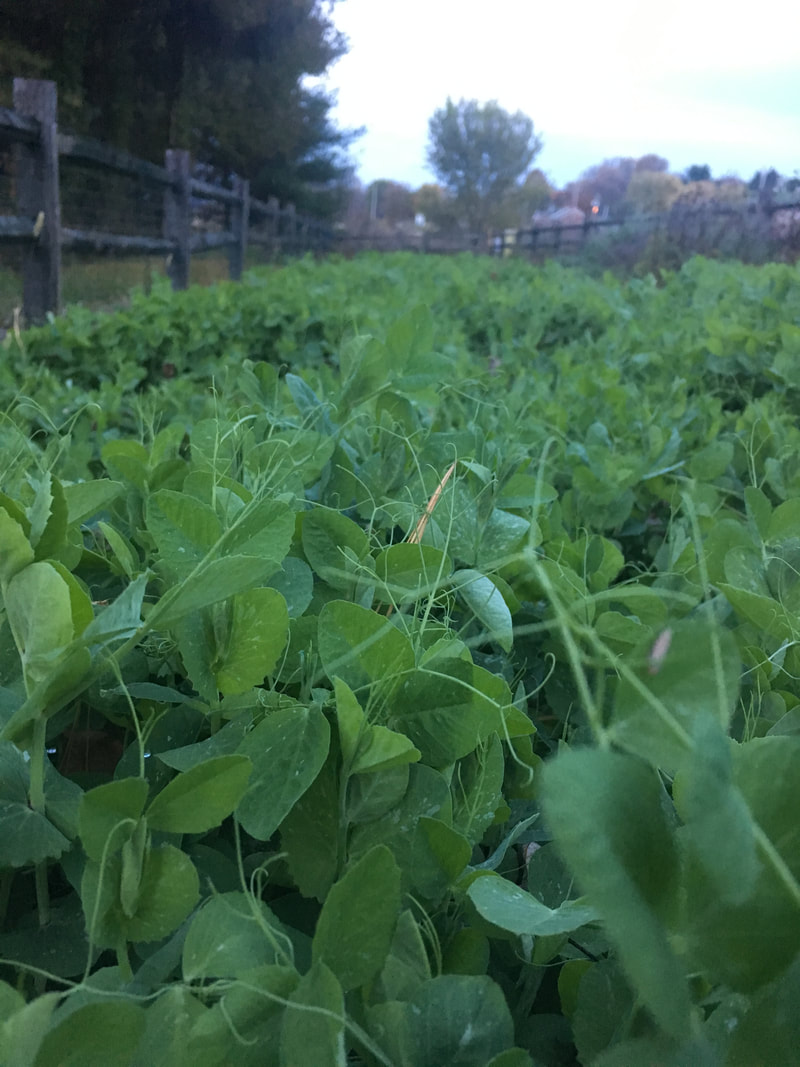|
Winter fare can be less than stellar when we have to resort to grocery store produce that's been trucked halfway across the United States to reach our plates. We all know we need to eat healthy, but getting your 5-a-day in Western Pennsylvania's off season can be tough - literally. Especially when it comes to greens. Visit any grocery store and grab at a bunch of kale or lettuce. It's wilted, lackluster, and flavorless. The farmers markets are long over, and the garden has been tucked in for the season. So what to do? Frozen, dried, or far-flung imports? Take your pick, you gotta eat! Here at WPNR we have good news for you. Winter doesn't have to be a bowl of dried peas reconstituted with boxed broth. It can be alive and teeming with brilliant green nutrients from the garden! Even while the garden is sleeping. Even in winter. Pictured above is a view of our Harvest Garden. This bed is indeed resting for winter, but it's packed full of young, tender pea shoots known as Austrian Winter Peas (Pisum arvense). These greens will survive to 10°F even under a blanket of snow and can be harvested all winter long. They not only look tantalizing, they taste like the freshest, sweetest peas you've ever eaten. But that's not the only reason we plant them. Every fall, after the growing season has yielded okra, pumpkins, garlic, and lots of other vegetables, a cover crop is planted to protect the soil. Cold, dry winds erode it, while gardening depletes it of vital nutrients. In order to keep the soil healthy it must be replenished. Austrian Winter Peas are one of many choices of legume cover crops. They're my personal favorite because they not only fix nitrogen in the soil, which is essential for healthy plant development, but this plant gives us something every season without fail . Win-win. We sow them in the fall, they quickly grow tender shoots and then the snow flies. It covers the pea shoots and they remain there all winter, under snow, sleet, and freezing rain, ripe for the picking. Then, as spring gently thaws the ground and the beds begin to warm in the sun, the peas resume growth. They develop beautiful fuschia flowers, and the bees appreciate the sweet early nectar. As they mature, we allow some plants to grow full pods and dry on the vine to be collected for next years seed crop, while others are pulled and layered in the beds as green mulch. We nest tender vegetable plants right inside it which helps to protect them by conserving moisture in the soil and suppressing weeds that compete for nutrients. The plants also break down over the growing season adding healthy biomass to the soil. When the harvest has come to fruition, we start all over again. If you've ever grown a bean plant from a seed (kindergarten science, anyone?) you can grow Austrian Winter Peas. It's insanely easy. In zones 5 and 6, they need to be planted mid-August to early September. The process is pretty simple: start by inoculating (a fancy word for swirl the peas in a cup with some water and rhizobium bacteria powder) the peas, throw them on some loose soil, rake them around a bit, water, keep moist until they germinate, and wait for your food to grow. That's it. If you already have a garden, you can plant them anywhere you have free space. You'll reap the benefits of every cycle of the plant in addition to enjoying the winter food crop. If you don't have a garden you can easily prepare a patch of soil to grow them in. Who knows, maybe it will inspire you to grow other vegetables in the spring! You might be wondering how to enjoy these lovely greens. There are endless ways to prepare them, but I quite like them raw as a salad. Cut into bite sized pieces with kitchen shears, dress with good olive oil, raw honey, a splash of balsamic, garlic, sea salt and pepper, and maybe a pinch of red pepper flakes for a kick. Simple and elegant. You can also do a quick saute' in butter with a sprinkle of sea salt, or even as a substitute for lettuce on a sandwich or wrap. Undoubtedly, you'll find yourself snacking straight from the garden and wondering why you hadn't planted them sooner. You can purchase peas and the inoculant from many online retailers and we are always available to answer any questions you might have. If you'd like to sample our peas, please stop by the barn and ask us, we love to share! Happy gardening and thanks for being a part of our neighborhood. AuthorJennifer Eppolito, Education Horticulturist
1 Comment
|
AboutThe Walzer Way Blog is maintained by WPNR staff with contributions from Saint Vincent College students and staff, volunteers, community members, and more. If you are interested in contributing to The Walzer Way Blog, contact the Learning Barn. Categories
All
Archives
March 2020
|



 RSS Feed
RSS Feed

